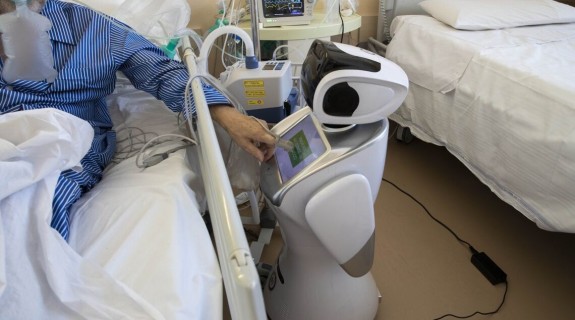Part 2: Automation in Greater Philadelphia's Healthcare and Social Assistance Industry
By: Mike Shields, Mohona Siddique, and Andrew Strohmetz
Date: November 4, 2020
Automation in Greater Philadelphia's Healthcare and Social Assistance Industry
In the second installment of our Automation Nation series, we dive deeper into automation trends in the U.S. healthcare and social assistance industry and discuss the potential impact in our region. As we previously noted, Greater Philadelphia’s healthcare and social assistance industry has long been a vital economic asset in terms of regional employment and services. The COVID-19 pandemic and the resurgent movement for racial equity have only amplified the critical role of this sector. What has gotten less attention, however, is that automation has proceeded apace in healthcare and social assistance industry, which may lead to significant changes in the nature of work and the composition of the industry’s workforce.

Greater Philadelphia’s Healthcare and Social Assistance Industry
As of August 2020, Greater Philadelphia’s healthcare and social assistance sector accounts for 516,000 jobs or 18.9 percent of the region’s total employment, making it the leading job engine among the region’s industries [1]. Anchored by local health systems and hospitals like Penn Medicine, Jefferson Health, Temple Health, Tower Health, and Main Line Health, the region’s healthcare and social assistance sector comprises an array of occupations with varying educational and skill requirements. While many medical-oriented professions require years of training and education, the growth of elder care, assisted living facilities, home care assistance, and community health centers has created numerous employment opportunities across all skill levels. However, as in other sectors many of these newer positions face a greater risk of automation if daily tasks are routinized enough to be replicated and replaced by technology.

Automation Potential in the U.S. Healthcare System
Like many other industries, the healthcare and social assistance industry has not been immune to automation. New developments like telemedicine, integrated electronic medical records, companion robots, and the 3D printing of prosthetics and organs may not be occurring right away, but continued investment and strategic planning around these future technologies shows that many health systems and healthcare-focused businesses are ready to pivot to the evolving future of work [2]. Despite ongoing investment and planning, current automation efforts within the industry have primarily occurred in non-clinical contexts. Data entry, record keeping, claims processing, prescription fulfillment, human resources, and financial services have all seen an influx of new software programs that have centralized information and output [3]. To read more about how automation and the future of work are impacting and shaping healthcare, please refer to the following sources:

The Pandemic’s Impact on Healthcare Automation
The COVID-19 pandemic catapulted many workplaces into the virtual world and accelerated automation across a wide array of industries [4]. With the increased need for social distancing, and the increased risk of contracting the highly infectious coronavirus in healthcare facilities, the healthcare and social assistance industry was quick to embrace virtual interactions where possible - perhaps most prominently with the rise of telemedicine. While the practice of medicine itself is not automated, the rise of telemedicine has increased the number of medical services that are provided virtually and simultaneously automated several associated tasks. Prior to the pandemic, roughly 18 percent of doctors provided virtual care; by April 2020, this estimation grew to 48 percent [5]. Many experts consider the rise of telemedicine as a tipping point that will change a series of administrative and patient experience tasks in medicine.
The unforeseen impact of the COVID-19 pandemic raises important equity considerations for the healthcare and social assistance workforce as well. The National Skills Coalition estimates that healthcare jobs are undergoing massive technological transformation, even if not a full transition to automation. However, the healthcare and social assistance workforce is not necessarily prepared for a twenty-first century economy from a skill-level perspective. In fact, one in three health care and social assistance workers lack key digital skills that are necessary for an increasingly tech-centered healthcare landscape [6].
To read more about telemedicine and the growing importance of digital skills in healthcare, please refer to the following sources:
The Leading Indicator
With Greater Philadelphia’s healthcare and social assistance industry accounting for just under a fifth of the region’s employment, we took a closer look at the automation potential of prominent occupations within the industry using the “automation potential” probability score developed by the Brookings Institution and the McKinsey Global Institute. Figure 1 details the average automation potential within each segment of the healthcare and social assistance industry and compares it with the metropolitan region as a whole.
FIGURE 1

Figure 1 demonstrates that the region’s healthcare and social assistance industry overall has a lower-than-average susceptibility to automation – a finding supported by a 2019 Brookings report on automation. But some individual segments are vulnerable, such as the Administrative, Insurance, and Sales, Health Technologists and Technicians, and Health Support sectors, which all have automation probability scores that exceed the region’s average. At the other end of the spectrum, Personal Care, Social and Community Assistance, and Health Practitioners all have automation probability scores far below both the region’s average automation potential and that of the overall healthcare and social assistance industry.
Figure 2 provides more context by showing the individual automation potential of the various occupations within each sector of the healthcare and social assistance industry.

FIGURE 2
NOTE: Data were obtained from Brookings’ 2019 Automation and Artificial Intelligence: How Machines are Affecting People and Places Report. "Low" automation potential is any occupation with a probability less than 33.34%, "Medium" automation potential is any occupation with a probability between 33.34% and 66.7%, and "High" automation potential is any occupation with a probability greater than 66.7%.
Occupations colored blue have a low automation potential, meaning that daily tasks are less likely to be replaced, diminished, or redistributed by the introduction of new technologies. A large share of the Health Practitioners and Scientific Research occupations fall in this category, as well as many Social and Community Assistance and Personal Care occupations. These occupations both require advanced training and most of their daily tasks cannot be routinized enough to be predicted or replicated by technology. These occupations also require critical thinking and quick adaption to new information which makes replacement by machines less likely in the near future. They have, however, become more susceptible to adopting technology to enhance their daily work; for example, many of these occupations have adopted telemedicine technology and techniques during the pandemic.
Occupations with medium automation potential are colored purple and include a variety of jobs. Unlike the low automation potential occupations, medium automation potential occupations have lower educational requirements and less variability in their daily tasks. Many of the Health Technologists and Technicians occupations are grouped here because much of their work relies on the use of technology or machines. Radiological Technologists, for example, use machines to create images of the human body that help with the diagnosis and treatment of an illness or condition. The entire occupation is dependent on a technology that, over time, could take on more tasks and duties originally performed by humans.
Finally, the high automation potential occupations are colored red. There are very few clinical- or community-health-focused high automation potential occupations within the Healthcare and Social Assistance field since many of these occupations are predicated on the evolving treatment of the physical, mental, and social ailments of humans. As noted in previous research, the occupations most susceptible to automation within this industry are mostly non-clinical. These occupations, such as Data Entry Keyers, Insurance Claim Processors, and Medical Transcriptionists perform daily tasks that tend to be routinized and have minimal variability. These occupations face the greatest risk of displacement by automation since new technologies have made it easier to digitally record and centralize medical and financial information.
In sum Greater Philadelphia’s healthcare and social assistance sector faces a much lower risk of automation than the food sector (detailed in the first installment of our Automation Nation series). Though the pandemic has accelerated and deepened some automation trends in some sectors of this very prominent industry, many occupations in healthcare and social assistance require human interaction, creativity, and emotional intelligence under non-standardized conditions that technology will not be able to replicate for some time.
Works Cited
[1] Bureau of Labor Statistics, U.S. Department of Labor. 2020. “Series SMU42379806562000001, All Employees, In Thousands for the Health Care and Social Assistance Industry in the Philadelphia-Camden-Wilmington, PA-NJ-DE-MD Metropolitan Statistical Area from 1990 to 2020 (Seasonally Adjusted).” Current Employment Statistics. Retrieved from: (https://www.bls.gov/data/).
[2] Deloitte Insights. 2019. The Future of Work: How can health systems and health plans prepare and transform their workforce? Deloitte Development LLC. Retrieved from: (https://www2.deloitte.com/content/dam/insights/us/articles/4816_fow_hea…).
[3] Chow, Yan. 2020. “Preparing for the Future of Healthcare in Light of Automation.” Automation Anywhere, 24 February. Retrieved from: (https://www.automationanywhere.com/company/blog/rpa-thought-leadership/…).
[4] Howard, Brad. 2020. “How coronavirus could usher in a new age of automation.” CNBC, 5 September. Retrieved from: (https://www.cnbc.com/2020/09/05/how-coronavirus-could-usher-in-a-new-ag…).
[5] Lee, Ed. 2020. “How COVID-19 accelerated the push toward telehealth.” Kaiser Permanente Business, 28 July. Retrieved from: (https://business.kaiserpermanente.org/insights/telehealth/covid-19-acce…).
[6] National Skills Coalition. 2020. Health workers need investment in their digital skills. Washington D.C. Retrieved from: (https://m.nationalskillscoalition.org/resources/publications/file/Digit…).